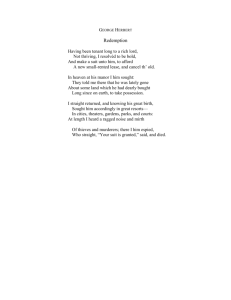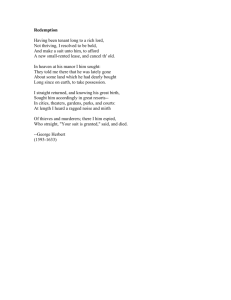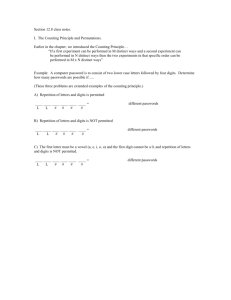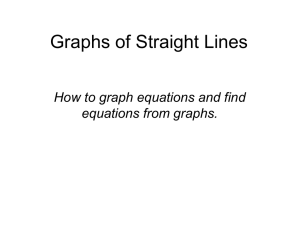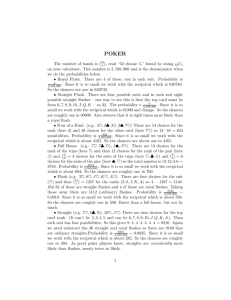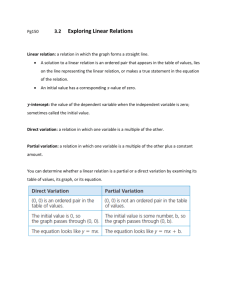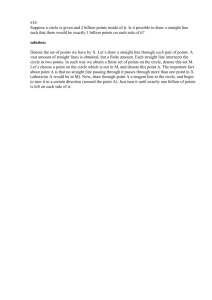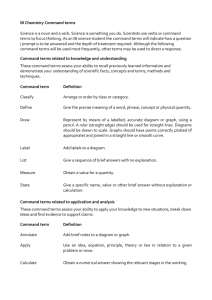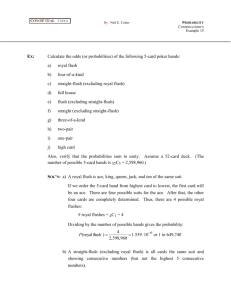Day 14 Class Notes
advertisement
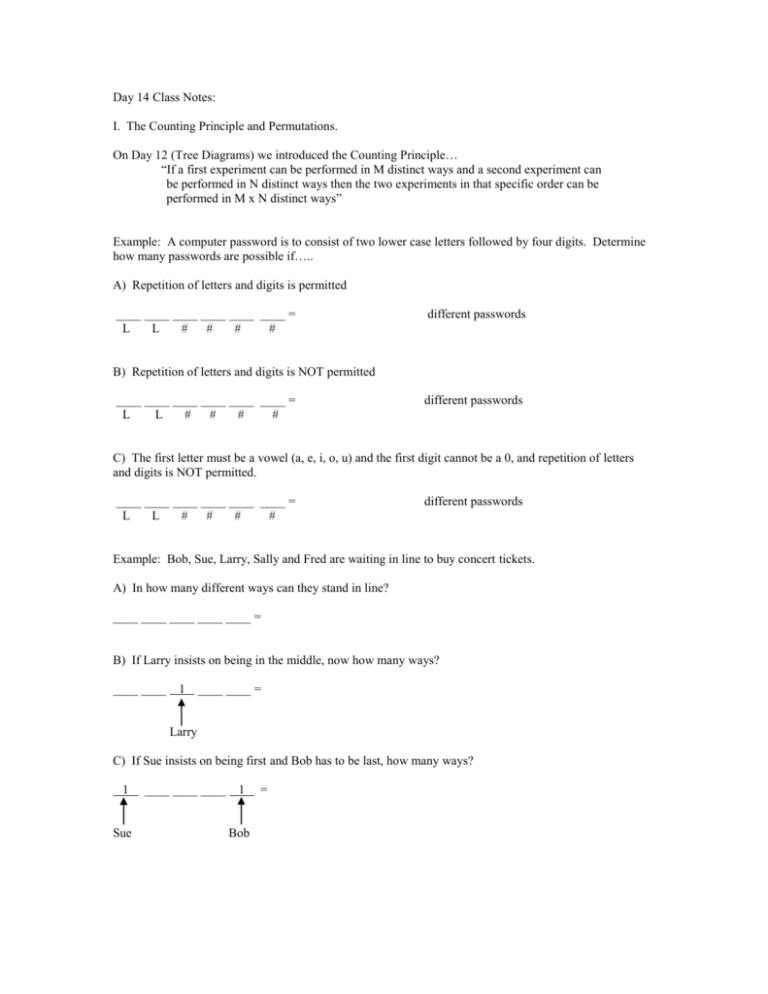
Day 14 Class Notes: I. The Counting Principle and Permutations. On Day 12 (Tree Diagrams) we introduced the Counting Principle… “If a first experiment can be performed in M distinct ways and a second experiment can be performed in N distinct ways then the two experiments in that specific order can be performed in M x N distinct ways” Example: A computer password is to consist of two lower case letters followed by four digits. Determine how many passwords are possible if….. A) Repetition of letters and digits is permitted ____ ____ ____ ____ ____ ____ = L L # # # # different passwords B) Repetition of letters and digits is NOT permitted ____ ____ ____ ____ ____ ____ = L L # # # # different passwords C) The first letter must be a vowel (a, e, i, o, u) and the first digit cannot be a 0, and repetition of letters and digits is NOT permitted. ____ ____ ____ ____ ____ ____ = L L # # # # different passwords Example: Bob, Sue, Larry, Sally and Fred are waiting in line to buy concert tickets. A) In how many different ways can they stand in line? ____ ____ ____ ____ ____ = B) If Larry insists on being in the middle, now how many ways? ____ ____ 1 ____ ____ = Larry C) If Sue insists on being first and Bob has to be last, how many ways? 1 Sue ____ ____ ____ 1 Bob = Permutations: A permutation is any ordered arrangement of a given set of objects. The number of permutations of “n” distinct items is n factorial , symbolized n!, where n! n n 1 n 2 n 3 3 2 1 P is the number of permutations possible when r objects are selected from n objects. n r n Pr n! n r ! ON YOUR CALCULATOR!!!!!! Example: How many different three letter “words” can be created from the letters S, T, A, R, P P 5 3 5! 5 3! ______ _______ _______ Example: If a club consisting of eight members wishes to randomly select a president, vice-president and secretary, how many different arrangements are possible? P ______ _______ _______ 8 3 Permutations of Duplicate Objects. The number of distinct permutations of n objects where n1 of the objects are identical, n2 of the objects are identical,……., nr of the objects are identical is found by the formula… n! n1 ! n2 ! n3 ! nr ! Example: In how many ways can the letters in the word “TALLAHASSEE” be arranged? Work: Of the 11 letters, three are A’s, two are L’s, two are S’s and two are E’s. So the total number of distinct arrangements are 11! 3!2!2!2! II. Combinations When the order of selection of the items is important to the final outcome, the problem is a PERMUTATION problem… Example: A president, vice-president and secretary are to be selected at random from David, Dan, Julie, Amanda and Steve. How many ways can this be done? ______ _______ _______ = Pres VP Sec OR 5 P3 Note: (Dan, Julie, Steve) is DIFFERENT than (Julie, Steve, Dan) When the order of selection is NOT important to the final outcome the problem is a combination problem. The number of combinations possible when r objects are selected from n objects is n Cr n! n r !r ! Example: How many different ways can three people from David, Dan, Julie, Amanda and Steve be selected to attend a meeting? 5 C3 5! 5 3!3! Note: (Dan, Julie Steve) is the SAME as (Julie, Steve, Dan) Example: 10 GCC students have applied for a scholarship. 6 students will be chosen to receive this scholarship, how many different ways can these 6 be chosen? 10 C6 Example: At a Chinese restaurant, dinner for eight people consists of 3 items from column A, 4 items from column B and 3 items from column C. If columns A, B and C have 5, 7 and 6 items respectively (from which to choose) how many different dinner combinations are possible? C C C choose 3 items choose 4 items choose 3 items from col A from col B from col C (5 choices) (7 choices) (6 choices) POKER: The number of possible 5 card poker hands that can be dealt from a deck of 52 cards is 52 C5 (There are 52 total cards ; 13 “types” 2, 3, 4, 5, 6, 7, 8, 9, 10, J,Q,K,A and 4 “suits” hearts, diamonds, clubs and spades) different hands, figure out how many of those are each of the following…. Of the A) 1 Pair (XXABC) C choose the type of pair (pair of 3’s, pair of J’s ?) C choose two of those 4 cards 3D,3H? B) 2 Pair (XXYYA) C C C C choose 3 lastly, for EACH of the three different last cards, choose one of the cards from possible “suits” the remaining 12 “types” C C C C C choose 2 of the 13 “types” to be your XX YY two pairs choose a choose a “suit” for “suit” for EACH card EACH card in your first in your second pair XX pair YY C) 3 of a kind (XXXAB) C C C choose the one choose 3 of “type” for XXX the possible four suits for XXX C choose your 5 th card to be one of the OTHER 11 remaining types NOT X and NOT Y C choose the last two cards A,B to be different than X lastly choose a suit for each of A and B D) 4 of a kind (XXXXA) C C C C choose the “type” choose all choose the 5th of card for XXXX four suits card from the (is this needed?) remaining 12 “types” finally, choose a suit for your 5 th card E) Full House (XXXYY) C C C C choose the “type” choose 3 choose the card of card for XXX of the 4 “suits” “type” for YY for XXX from the remaining 12 “types” choose 2 of the possible 4 suits for YY F) Royal Straight Flush (10,J,Q,K,A ALL of the same suit) choose a “suit for the 5th card (all we have to do in this one is choose a “suit” , the cards are already determined) C (that is to say there are only royal straight flushes… 10 – A of hearts, diamonds, clubs and spades) G) Straight Flush ( five consecutive cards from A,2,3,4,5,6,7,8,9,10,J,Q,K,A…all of the same suit BUT NOT a Royal Straight Flush) C choose a “starting” card for your 5 card straight A,2,3,4,5,6,7,8,9,10 choose 1 of the four suits for the straight subtract out the royal straight flushes that would have been counted in the first part H) Straight ( five consecutive cards from A,2,3,4,5,6,7,8,9,10,J,Q,K,A…NOT all of the same suit) C C choose a “starting” card for your 5 card straight A,2,3,4,5,6,7,8,9,10 C C C now choose a “suit” for each of the 5 cards in your straight subtract out the hands that would be straight flushes ( and royal straight flushes ( ) ) I) Flush ( five cards all of the same suit BUT NOT a straight flush or a royal straight flush) C choose a suit for your flush C choose any 5 cards of the 13 “types” subtract out those flushes that end up being straight flushes ( and royal straight flushes ( ) )

